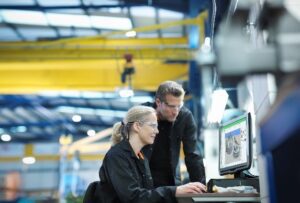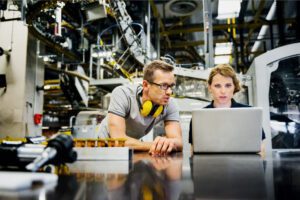
Today’s changing customer demands have rendered traditional machine design/build processes obsolete. End-users expect fully commissioned, production ready smart machines which perform with improved speed and reliability. Meanwhile OEMs are finding new ways to design, build, and maintain machines to minimize development and start up time.
One of the most promising new approaches is the use of digital twins to develop, deploy and operate smart machines.
A digital twin is a virtual model that OEMs can use to:
- Test control logic through detailed graphics, virtually commissioning the system either with or without the hardware.
- Minimize the potential for design errors and streamline machine build processes.
- Pinpoint where to gain efficiencies and avoid instances of downtime.
- Pair the virtual and physical worlds (the twins), data analysis, and monitoring systems to help proactively avoid problems before they occur.
The big advantage digital twins offer over other more traditional tools like CAD is their ability to simulate and document the impact of changes to a machine’s design without the need to invest to build physical prototypes.
Digital twins offer advantages across the entire machine lifecycle
New 3D digital twin tools such as Schneider Electric’s EcoStruxure Machine Expert Twin platform bring value to OEM and end-customer interactions at all key machine lifecycle phases:
- Increased machine sales – The 3D animations visually demonstrate to potential clients, in clear detail, what their machines will look like and how they will operate before the machine is ever built. This powerful tool drives customer interest and sets realistic shared expectations. Digital “proof of concept” activities enable more collaborative interactions with potential customers and early validation of machine design concepts.
- More reliable machine design – The use of pre-built programming objects makes it easier for engineers to achieve machine quality consistency and provides the flexibility to simply modify and validate design ideas, even for highly complex automation systems. During the R&D design and machine development phases, virtual engineering facilitates differentiated, high-speed machine designs with up to 30% improvement in design quality.
- Faster machine build – The digital twin easily imports data from multiple sources such as AutoCAD systems, Excel spreadsheets, XML, and pre-built templates from past-projects. The software’s multidimensional database eliminates the need to make hundreds of copies within the same project. It allows for graphical representations, status configurations, revision data layers, and operational parameters within the same project file. Reference design templates can also help remove the duplicate work which typically occurs during future projects. This approach saves hundreds of hours when designing and building machines. A 20-40% savings in investment costs can be realized due to faster time-to-market, increased software quality, and reduced future downtime.
- Higher commissioning speed and performance certainty – 60% of commissioning time is spent resolving control software, protocol, and integration issues. However, many of these delays can be avoided by using digital modelling tools. Engineers no longer need to wait until the machine is built to perform commissioning tasks. Tests can take place digitally using only a PLC and the virtual model. Virtual software control testing, factory acceptance testing (FAT), and commissioning make it easier and less costly to perform systems integration and software quality evaluation as these no longer have to be performed in detail on-site.
- Smoother machine operation – Digital twin tools also allow OEMs to offer their client post-installation services that can generate new revenue streams. Services such as operator training, testing of software upgrades, downtime prevention, and performance efficiency evaluations all help OEMs develop a broader relationship with their client base. Remote services enabled by a digital twin, running on-premise at the production site, parallel to the real machine allow OEMs, plant engineers, and operators to pinpoint where to make efficiency gains. This results in fewer instances of unscheduled machine downtime and a 50% improvement in Overall Equipment Effectiveness (OEE).
Combined efficiencies drive innovation and development speed
EcoStruxure Machine Expert Twin digital twin software enables engineers to bring the machines they develop to market 20-50% faster. Engineers can use the EcoStruxure Machine Expert Twin platform to run different machine component combinations and to see how those various options impact machine behavior. Such tools enable bolder and more creative planning, improved uptime through superior maintenance of machines, enhanced profitability, and more effective compliance with changing regulations.
The EcoStruxure Machine Expert Twin platform is based on an open Microsoft.net framework which allows easy customization and adaption to end-user requirements. Since the platform is easily scalable, machine simulation can perform regardless of machine size, type or complexity. To learn more about how EcoStruxure Machine Expert Twin software addresses today’s machine design requirements, read our latest whitepaper or visit our website to download a free trial.



